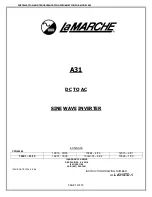
500-004941-000
3-4
associated 16 bit pitch counter with one transfer cycle. The data transfer logic also
supports 8 and 16 bit transfers.
3.4
RESOLVER CONVERTER MODULES
The four resolver-to-digital converter modules utilized are the ILC Data
Device Corporation RDC-19200 MONOBRID Series modules. The RDC-19200
Series Converters are versatile state-of-the-art resolver to digital converters
featuring programmable functions such as: resolution, bandwidth, and a scalable
velocity output voltage. Resolution programming allows selection of 10-, 12-, 14-,
or 16-bit. Models are available with accuracy to ±2 1 LSB. Resolution
programming combines the high tracking rate of a 10-bit converter with the
precision of a 16-bit device in one module.
3.4.1
Introduction
The RDC-19200, includes three main parts: the signal input; a feedback
loop whose elements are the control transformer, demodulator, error processor,
VCO and up-down counter; and digital interface circuitry including various latches
and buffers. Either 11.8 V or 2 V resolver inputs are offered with the RDC-19200
series. The 11.8 V input is differentially coupled and the 2 V input is direct coupled.
The 2 V option eliminates the need for an input scaling network and allows
operation with a lower reference voltage. Figure 3.4.1-1 shows a typical DDC-
19200 used on the VMIVME-4941.
In a resolver, shaft angle data is transmitted as the ratio of carrier
amplitudes across the terminals. The internal converter operates with signals in
resolver format, sin
Ω
coswt and cos
Ω
coswt. The feedback loop produces a digital
angle 0 which tracks the analog input angle • to within the specified accuracy of
the converter. The control transformer performs the following trigonometric
computation:
sin (
Ω
-0) = sin
Ω
cos0 - cos
Ω
sin0
Where
Ω
is the angle representing the resolver shaft position, and 0 is the digital
angle contained in the up/down counter. The tracking process consists of
continually adjusting 0 to make (
Ω
-0) equal to zero, so that 0 will represent the shaft
position •. The output of the demodulator is an analog DC level proportional to sin
(
Ω
•-0). The error processor receives its input from the demodulator and integrates
this sin(•-0) error signal which then drives a Voltage Controlled Oscillator (VCO).
The VCO's clock pulses are accumulated by the up/down counter. The velocity
voltage accuracy, linearity and offset are determined by the quality of the VCO.
Functionally, the up/down counter is an incremental integrator. Therefore, there are
two stages of integration which make the converter a Type II tracking servo. In a
Type II servo, the VCO always settles to a counting rate which makes d0/dt equal to
Artisan Scientific - Quality Instrumentation ... Guaranteed | (888) 88-SOURCE | www.artisan-scientific.com
















































